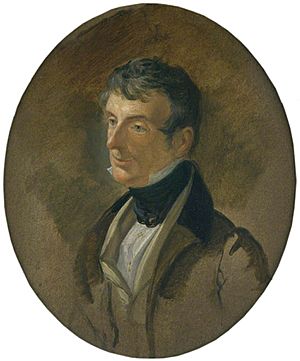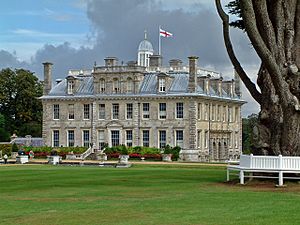William John Bankes facts for kids
Quick facts for kids
William John Bankes
FRS
|
|
|---|---|

Portrait by George Sandars, 1812
|
|
| Member of Parliament for Truro |
|
| In office 1810–1810 |
|
| Preceded by | Charles Powlett, 2nd Baron Bayning |
| Succeeded by | Sir George Warrender, 4th Baronet |
| Member of Parliament for Cambridge University |
|
| In office 1822–1826 |
|
| Preceded by | John Henry Smyth |
| Succeeded by | John Copley, 1st Baron Lyndhurst |
| Member of Parliament for Marlborough |
|
| In office 1829–1832 |
|
| Preceded by | James Brudenell, 7th Earl of Cardigan |
| Succeeded by | Henry Bingham Baring |
| Member of Parliament for Dorset |
|
| In office 1832–1835 |
|
| Preceded by | Edward Portman, 1st Viscount Portman |
| Succeeded by | Anthony Ashley-Cooper, 7th Earl of Shaftesbury |
| Personal details | |
| Born | 11 December 1786 |
| Died | 15 April 1855 (aged 68) Venice, Kingdom of Lombardy–Venetia |
| Nationality | British |
| Political party | Tory |
| Relations | Henry Bankes (father), Frances Woodley (mother) |
| Alma mater | Trinity College, Cambridge |
| Occupation | Explorer, egyptologist and adventurer |
| Military service | |
| Allegiance | United Kingdom |
| Branch/service | British Army |
| Rank | aide-de-camp |
William John Bankes (born December 11, 1786 – died April 15, 1855) was an English politician, explorer, and adventurer. He was also very interested in ancient Egypt, making him an Egyptologist.
William was the first surviving son of Henry Bankes MP. His family, the Bankes family, lived in Dorset. He asked Sir Charles Barry to redesign their family home, Kingston Lacy, using stone. William traveled a lot in the Near East and Egypt. He collected many ancient Egyptian items. His work on Egypt is now seen as very important. He was a close friend of famous people like Lord Byron and Sir Charles Barry. William also served as a Member of Parliament (MP) for several areas: Truro in 1810, Cambridge University from 1822 to 1826, Marlborough from 1829 to 1832, and Dorset from 1832 to 1835.
Early Life and Education
William Bankes was born in 1786. His parents were Frances Woodley and Henry Bankes, who was an MP. They lived at Kingston Lacy and Corfe Castle in Dorset. William was the second of five children, but the oldest son who survived.
He went to Westminster School for his early education. Later, he studied at Trinity College, Cambridge. He earned his first degree in 1808 and a master's degree in 1811. While at Trinity, he became good friends with Lord Byron, who was also a student there. William sometimes traveled with Byron in Europe. Byron even called him the "father of all mischief."
Adventures and Discoveries
William Bankes loved exploring and discovering new things. He was especially fascinated by ancient Egypt and beautiful art. He kept many notes, writings, and drawings from his trips. He traveled along the Nile River and explored Egypt, Nubia, and the Near East. These records are very valuable today. They show us what some ancient writings and monuments looked like.
William inherited Soughton Hall in Wales from his great uncle. In 1835, he also inherited his family's main home, Kingston Lacy. This mansion was William's home for many years. It still holds his huge collections of art and ancient artifacts.
Sir Charles Barry, a famous architect, was a long-time friend of William. They met in 1819 at the temple of Rameses in Abu Simbel. There, William drew pictures and arranged to move a special stone pillar called an obelisk from Philae. This obelisk can still be seen in the gardens of Kingston Lacy today. William respected Barry's skills very much. Barry did a lot of building work on the Bankes family properties. Barry is famous for designing the Palace of Westminster and the Victoria Tower.
While traveling in Spain and Portugal during the Peninsular War, William worked for the Duke of Wellington. The Duke later helped William when he faced difficulties. The Duke also celebrated William's successes. He was present at Kingston Lacy when the foundation was laid for the Philae obelisk.
William was also interested in architecture and was good at copying ancient writings. He was very keen on Egypt and tried to understand ancient Egyptian hieroglyphs. With help from his friend Charles Barry, William changed Kingston Lacy. They covered the brick house with stone. He also collected many Spanish paintings and items from Ancient Egypt. These collections are still at Kingston Lacy.
He became a member of the Fellow of the Royal Society in March 1822. In 1853, William ordered 16 bronze tortoises from a sculptor named Carlo Marochetti. These tortoises were made to support decorative marble urns at Kingston Lacy. Their design was based on one of William's own pet tortoises. Four of them were stolen in 1992 but were returned in 2021.
Later Life and Legacy
In 1841, William Bankes had to leave his home in England. He went to live abroad. Even though he could not return to Kingston Lacy, he kept collecting items from other countries. He sent his new collections back to his beloved home to be displayed.
It is thought that he secretly visited Kingston Lacy to see his home and collections before he passed away in Venice. He was buried in his family's burial place in Wimborne Minster.


